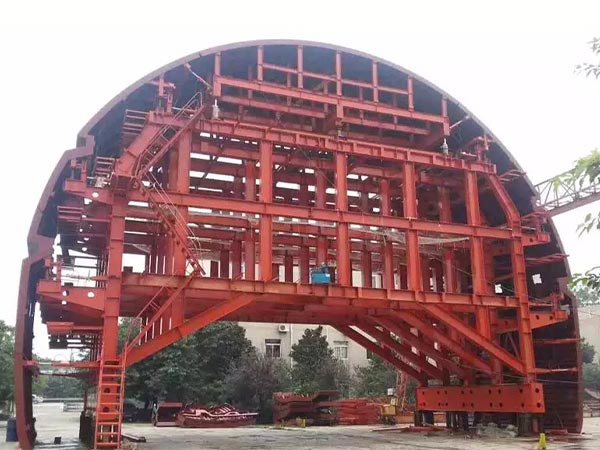Selection of tunnel lining materials
The so-called lining refers to the artificially constructed supporting structure, which can be collectively referred to as lining. The tunnel lining can be divided into initial supporting and secondary supporting (secondary lining). Tunnel lining materials should first have sufficient strength, durability, impermeability, corrosion resistance and frost resistance. In addition, from the economic point of view, it should also meet the requirements of local materials, reduce cost, convenient construction and easy mechanized construction.
Concrete
Advantages: good integrity, can be cast on site, can also be prefabricated in the processing field, and can be mechanized construction. Admixtures can be added to cement to improve the performance of concrete.
Disadvantages: It cannot bear the load immediately after pouring, it needs to be cured, and the mold can only be disassembled when it reaches the predetermined strength, which takes up more templates and arches. Ordinary concrete has poor corrosion resistance.

Flake concrete
(1) For railway tunnels, in order to save cement, flaky concrete is allowed to be used in the side wall lining in a good section of rock (the amount of flake should not exceed 20% of the total volume). In addition, when there is over-excavation over 1m above the arch line, the over-excavation part can also be backfilled with flake concrete.
(2) The selected stone should be hard, and its strength level should not be lower than MU40. Stones with cracks and easy weathering should not be used to ensure quality.
(3) Lining of highway tunnels is generally not required, and only flake concrete masonry can be used in the filling or over-excavation of the overhang. The dosage of flakes shall not exceed 30% of the total volume.
RC
It is mainly used in open cut sections such as Dongmen and Mingdong lining, or when the tunnel passes through the seismic area, bias pressure, through fault fracture zone or silt, quicksand and other unfavorable geological sections.
Stone and concrete prefabricated blocks
Advantages: It can take materials on site, reduce the cost, can guarantee the thickness of the lining and can bear the load earlier, can save cement and formwork, and has good durability and corrosion resistance.
Disadvantages: poor integrity, easy leaking of masonry joints, poor waterproof performance, construction mainly depends on manual operation, difficult to mechanize construction, laborious and time-consuming, slow construction progress, and high masonry technical requirements. Cave door retaining wall, earth retaining wall, clear line edge stone, etc. can still be used. The strength level of the block stone should not be lower than MU60, the strength level of the block should not be lower than MU20, and cracked and easily weathered stone should not be used.

Shotcrete
Shotcrete is formed by condensing dry mix of concrete, quick-setting agent and water with a high-speed concrete jetting machine on a clean rock surface.
It has high compactness and can quickly close the cracks of the surrounding rock. Close to the rock surface, the early strength is high, which can quickly play a role in closing the rock face and supporting. In addition, fiber materials can be added to the shotcrete to improve its performance. It is an ideal lining material.
In ordinary railway tunnels, the shotcrete material can be used as the inner lining, but its strength level is not less than C20, the cement grade used is not less than 32.5, and ordinary portland cement is preferred. Fine aggregate is made of hard and durable medium sand or coarse sand, the fineness modulus should be greater than 15, and the moisture content of sand should be controlled at 5% -7%; coarse aggregate is made of hard and durable pebbles or gravel, and the particle size should not be greater than 15mm. In China’s high-speed railway tunnels, shotcrete is not used as the inner lining.
Anchor rod and steel frame
An anchor rod is a rod-shaped member inserted into the surrounding rock body to strengthen the surrounding rock. Can be divided into mechanical anchors, bonded anchors and prestressed anchors. The diameter of the rod body of the anchor rod should be 20-32mm, the material of the rod body should be HRB335, HRB400 steel; the material of the backing plate should be HPB235 steel. The strength of various cement mortars used for anchor rods should not be lower than M20. The steel mesh material can be HPB235 steel, and the diameter should be 6-12mm.
The steel frame is a section steel support or grid steel support placed in the initial support or secondary lining in order to strengthen the support rigidity.
The steel frame used for the initial support should be made of H-shaped, I-shaped, U-shaped steel, and can also be made of steel pipes or rails.

Prefabricated materials
For shield construction, the lining materials are often fabricated materials, such as large reinforced concrete prefabricated blocks and reinforced rib cast iron prefabricated blocks.
In the construction of shed-type caves (abbreviated as shed-holes), prefabricated slabs or beams can be used to assemble plate-type sheds or beam-type sheds.
When using the new Austrian construction method, in order to waterproof, anti-rockfall and aesthetic requirements, you can also add a wall structure, commonly used materials are corrugated steel arch-type large-scale prefabricated parts, sometimes FRP can be used instead of steel.
In order to improve the lighting, waterproof, ventilation, beauty, sight induction or reduce noise in the cave, various decoration materials can be pasted on the inner surface of the lining.


